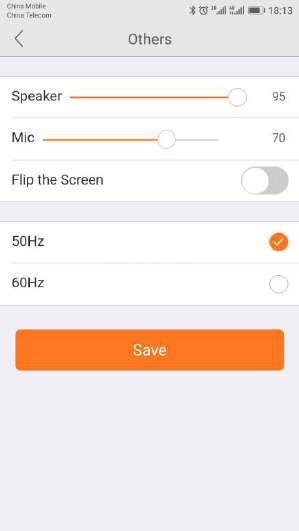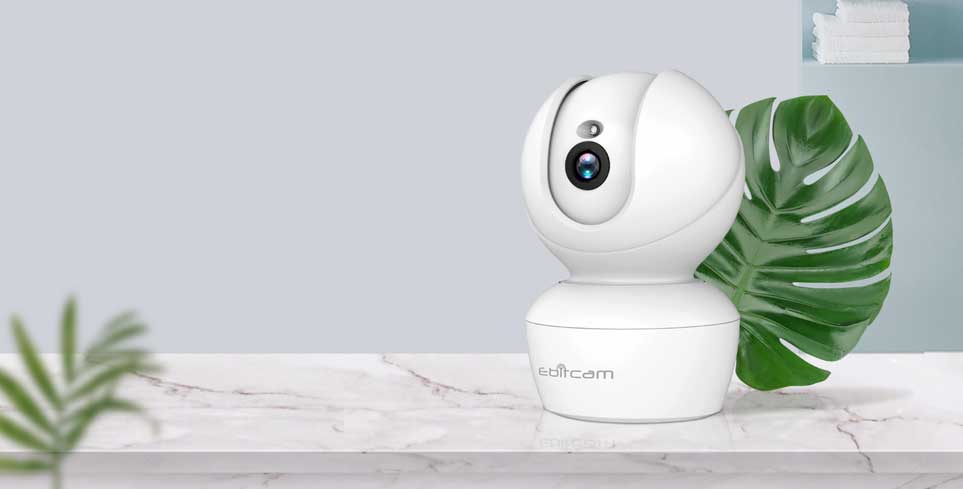Ebitcam Setup And User Guide
Ebitcam is committed to be the global leading provider of smart space service. We offer: Smart Security Products ( Cloud Cameras, Cloud Box and Alarm Devices), Smart Home Series Products and Cloud Services( Cloud Storage, Big Data Processing, Artificial Intelligence, etc.)
As a national high-tech enterprises and double soft enterprise, Ebitcam always adheres to user-oriented, technological innovation as the driving force, and continue to create high-value products and services for users. We already has hundreds of core intellectual property rights, and all products have passed FCC/CE/ROHS etc. international certifications.
How to use Ebitcam PC Client
Using the Website browser or PC client
To access camera via web browser or download for PC client, please visit https://www.ebitcam.com/device . Connect camera to your network with the included Ethernet cable.
Log In & Sign Up
The following window will appear in the web browser and on the client side
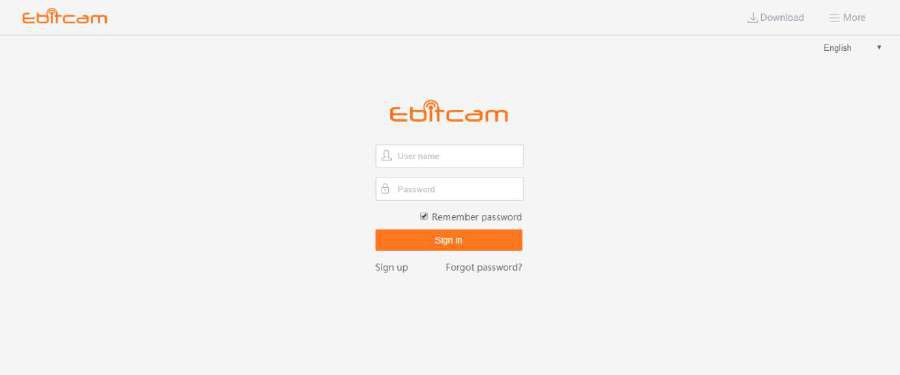

Note: for better viewing experience, you can download the EBITCAM PC client by clicking the “Download” in the upper right corner of the login screen.
Ebitcam Setup And User Guide
Read More : Danale Wireless Camera Installation Guide
Main Interface
The camera features a number of different settings, all of which you will be able to access through the main interface. Keep in mind that when you are changing the settings, which we will be discussing in this chapter, the camera must first be live and active.
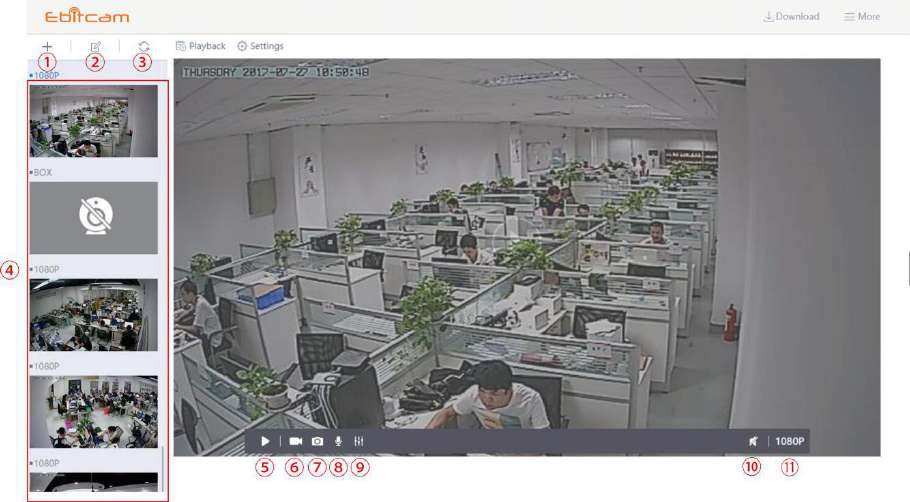
①Device Add button:Click the “+” to complete the device addition according to the wizard.
②Device delete button:Click to delete the added device.
See also How to add Ebitcam camera
③Device refresh button: Show all device thumbnails
④Device Thumbnails: For each device that has been added to the account, one thumbnail appears. Below the image, the Nickname of the device is listed.
⑤Stop/ Play:Press the button and you will be able to see the live feed.
⑥Record:to initiate a live recording.
⑦Snapshot:to create a snapshot image of the current view.
⑧Microphone:to transmit your voice through the device.
⑨Image setting:which enables you to set the mode for brightness, contrast, saturation, etc.
⑩Speaker:to transmit remote sounds.
⑪Resolution:user can choose the resolution of the images.
Pan, Tilt
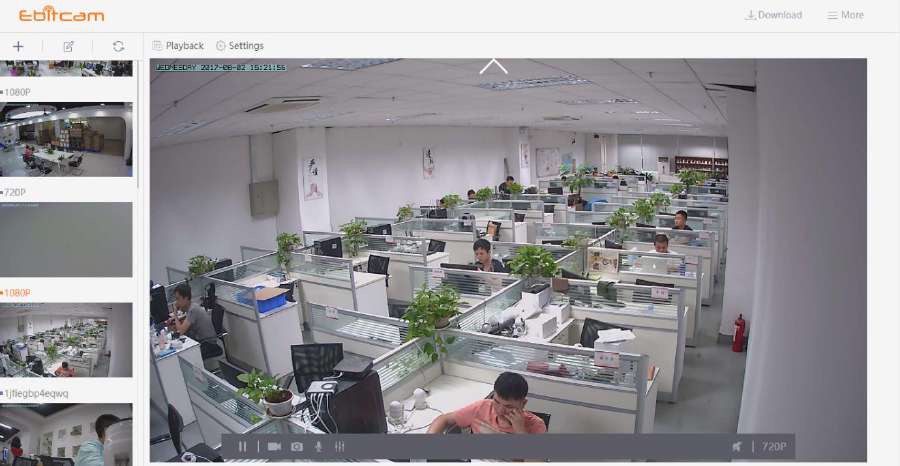
On computers only: move camera left, right, up and down using directional controls. These controls are only available as you move the mouse to hover over the display edges (top,bottom, left and right in the middle). Not all cameras provide the full range of rotation, panning, tilting, etc.
Note:The screen can not be zoomed on the computer.
Playback
If you do not have an SD card in your camera, this will be a blank screen. If you do have an SD card in your camera and you capture videos, you will see a list of videos on the this screen.
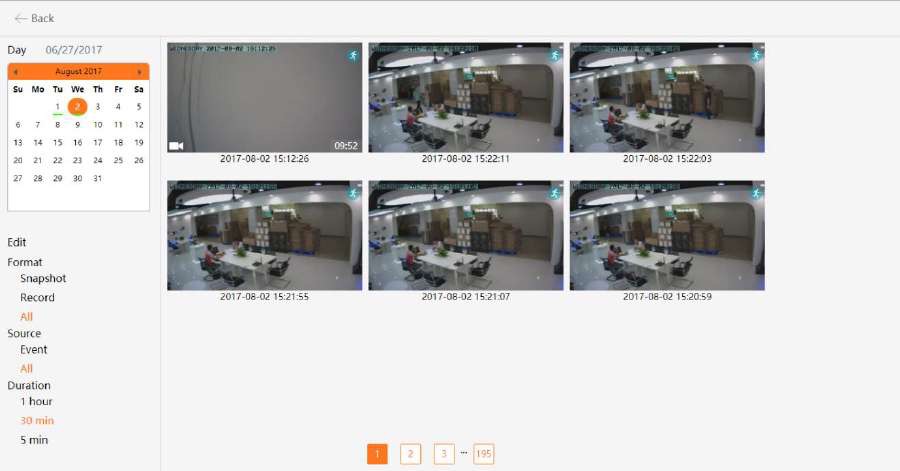
See also How to add Ebitcam camera
Settings
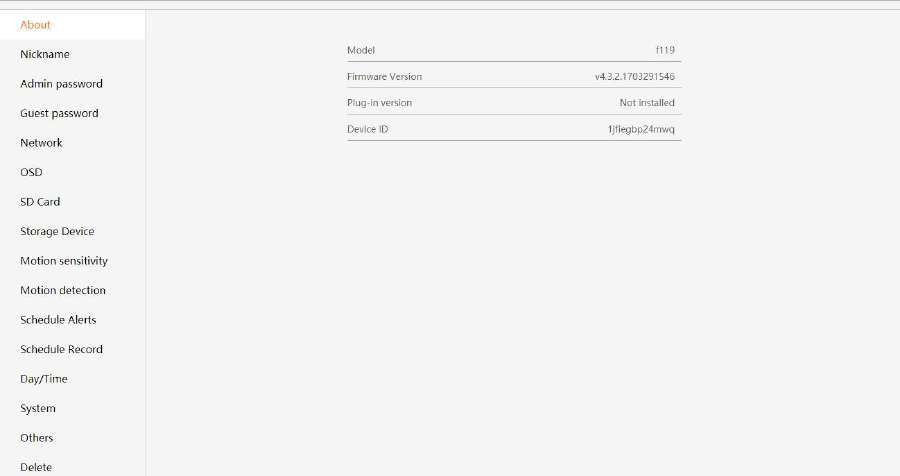
More (Account Settings)

The Settings page contains the following options:
How to add Ebitcam camera
Introduction
Thank you for making the choice to purchase Ebitcam Camera. We’re sure that you will love everything that this fantastic security camera has to offer from the ease of setup and use to all of the fantastic features it offers. In this manual, we’ll cover everything you need to know about the camera, including how to set it up, how to download apps for your smartphone, and how to control all of the aspects of the camera right through our website.
Let’s get started so you can get your camera set up and running to provide you with that added measure of security you need for your peace of mind.
What Is the Ebitcam Camera?
The Ebitcam Camera offers users a number of functions that help to make it an ideal solution to those looking for added security and peace of mind in both home and office settings. Let’s examine some of the biggest benefits you will find now that you’ve chosen to use this security camera.
Traditional IP cameras tend to be difficult to install and use. The Ebitcam Camera does not have this issue. It’s relatively simple to set up and use, as you will see through the course of this manual. It is a plug and play system, and offers a wealth of different features.
In addition, it offers:
Users will be able to work control and use their security camera through a variety of different devices, including iOS and Android devices. We will cover those devices, as well as how you can use them, throughout the course of this book.
Quick install and connect
One of the best features of this camera is the fact that you can operate and control it through multiple sources. You can use the interface on your computer at the www.ebitcam.com site, or you can download an app for your iOS or Android device – it will work with both phones and tablets. Let’s examine how you can get and set up the app on each of these different platforms.
You can operate and control the cameras in several way by downloading and installing the Ebitcam app, available for the following platforms:
iOS or Android device (both phones and tablets). To use the application, you need to have:
– iOS devices: iOS 5.0 or above – Android devices – Android 2.1 or above; at least 600MHz. Laptop or computer for Windows or MAC Webpage on the website by logging into your account at the www.Ebitcam.com site. The following sections detail installing and using the Ebitcam mobile app for iOS and Android devices.
Downloading the Ebitcam App
Download ‘ Ebitcam ‘ APP from APP Store(iOS ) or Google Play Store(Android).
PC users please download our APP: https://www.camapp365.com/ebitcam/ebitcam-for-pc
Creating an Account
To use the camera, you will need to set up an account with Ebitcam.
To create an account:
Logging in to the EBITCAM Account
Note: If you forgot your password, you can click the Forgot password link.
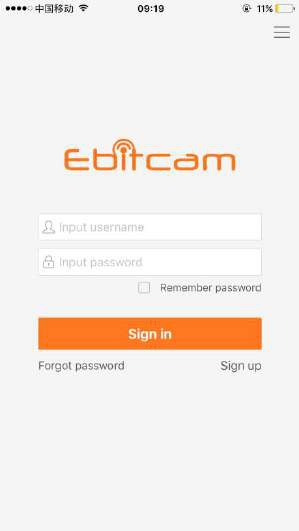
Connecting the Device
Access to the camera is accomplished with an Ethernet or Wi-Fi connection:
See also How to use Ebitcam PC Client
To connect your device to your network:
Note: This only needs to be done once during the initial setup. After you connect your device to the network, you need to log in to your EBITCAM account and add the device to it.
Add camera to account
Click on ‘+’ in top left corner, select the device model, scan the QR code and add the device ID, and enter the network connection interface.
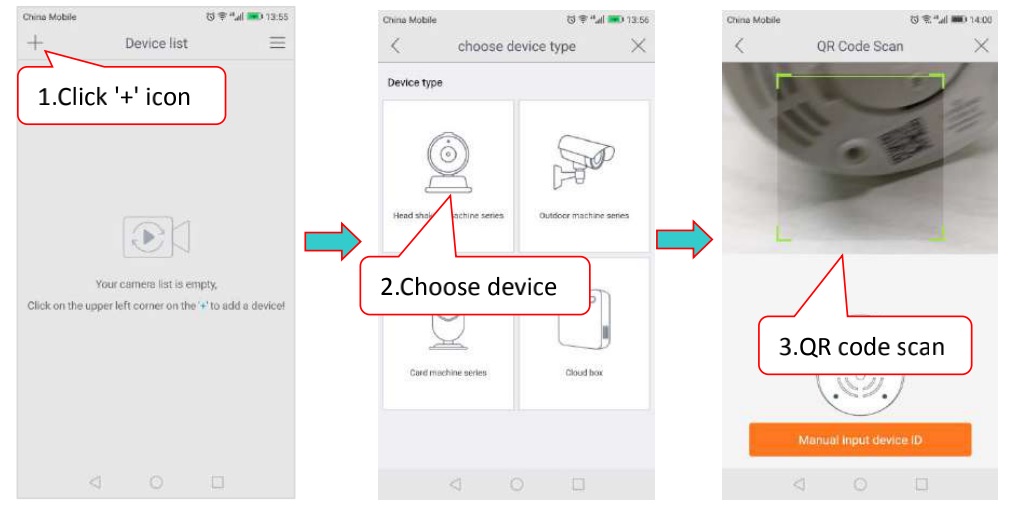
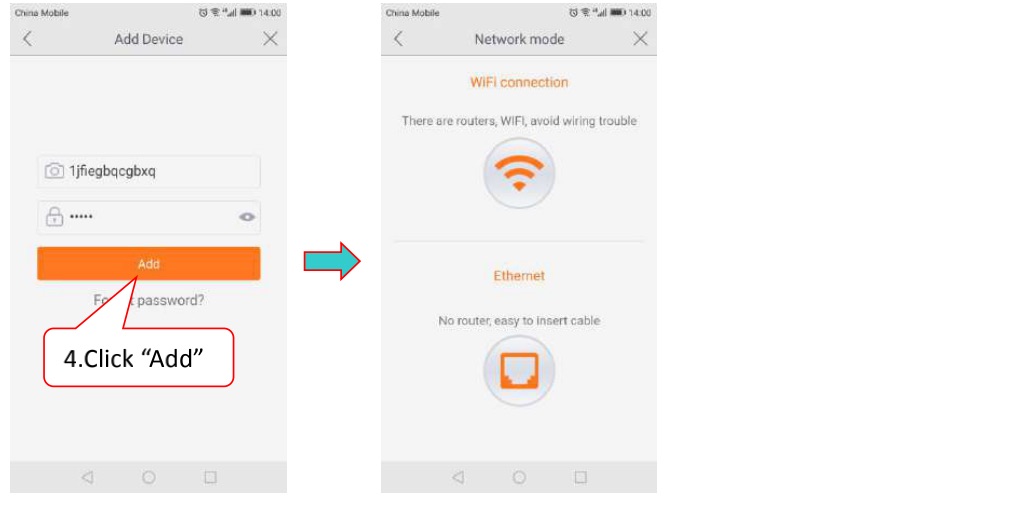
Select network connection method
When network configuration, you can choose Wi-Fi configuration or ethernet configuration.
Wi-Fi connection
Click the WiFi connection icon and press the RESET button to enter the WiFi configuration mode. Input the WiFi password, the connection should besuccessful!
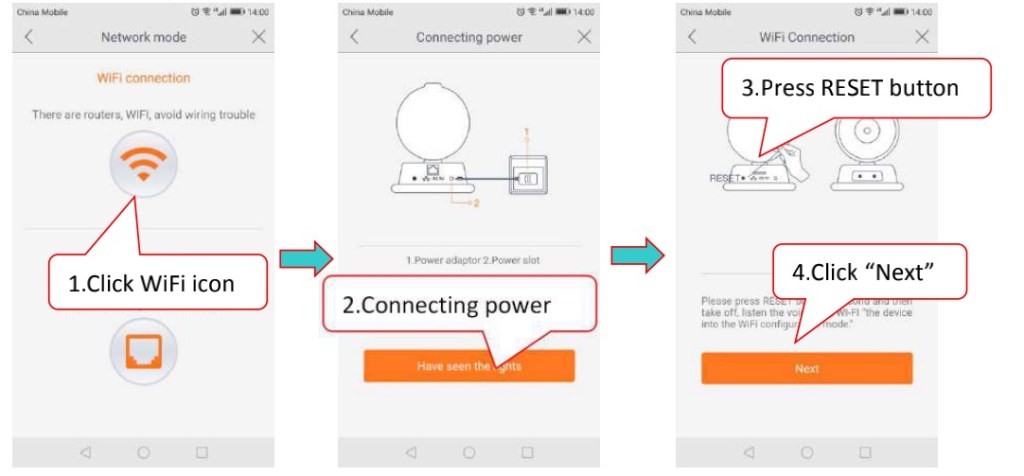
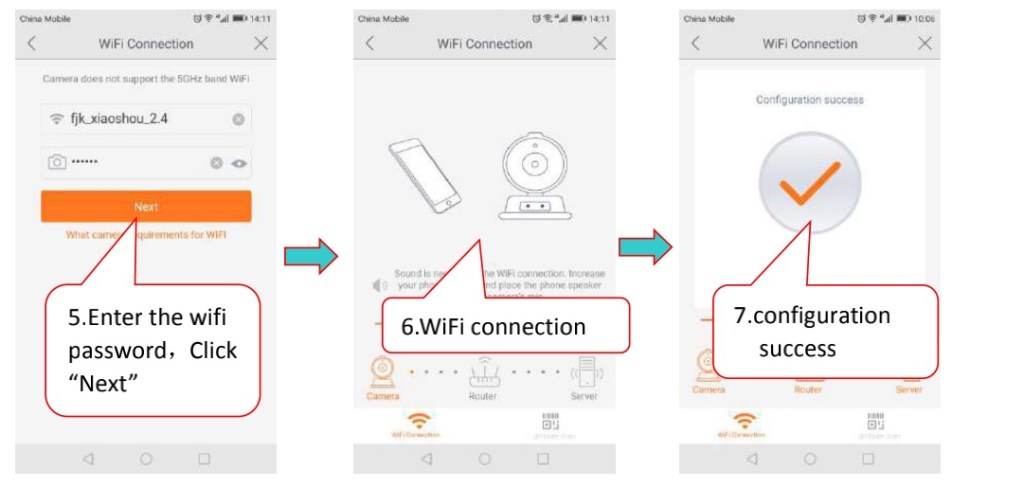
Note: ① Press RESET key, hold for 1-2 seconds to enter the WiFi configuration,longpress10-12 seconds to restore the factory settings.
② If the WiFi configuration fails, check the following:
· That your wireless network is turned on and active.
· That you have entered the correct Wi-Fi password.
· That your Wi-Fi is 2.4 Ghz. If it still unable to connect, try to connect using an Ethernet cable.
③ The Outdoor Cameras only supports wired connections for WiFi.
Ethernet connection
Plug in the network cable and click the Ethernet Connection icon to connect to the network, change the password, rename the device, set the time zone and you are now ready to access the device.
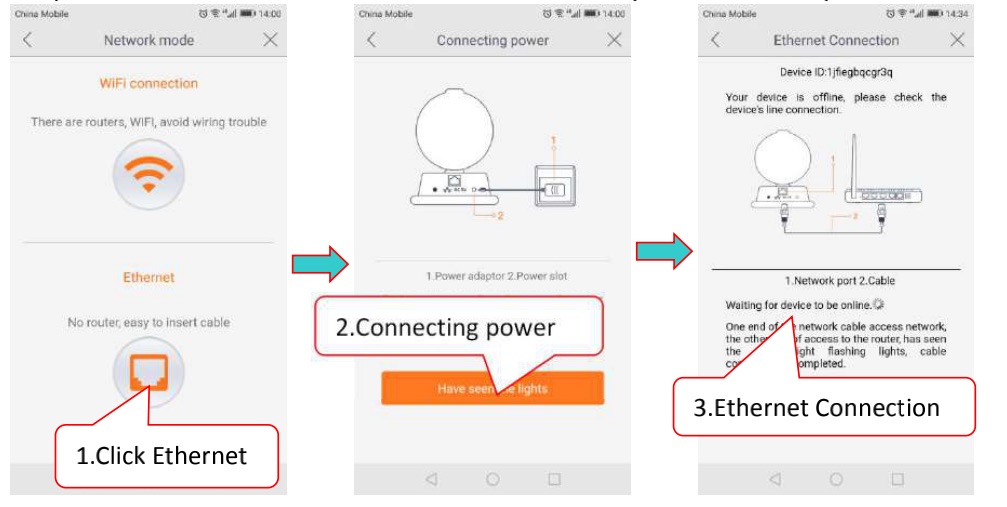
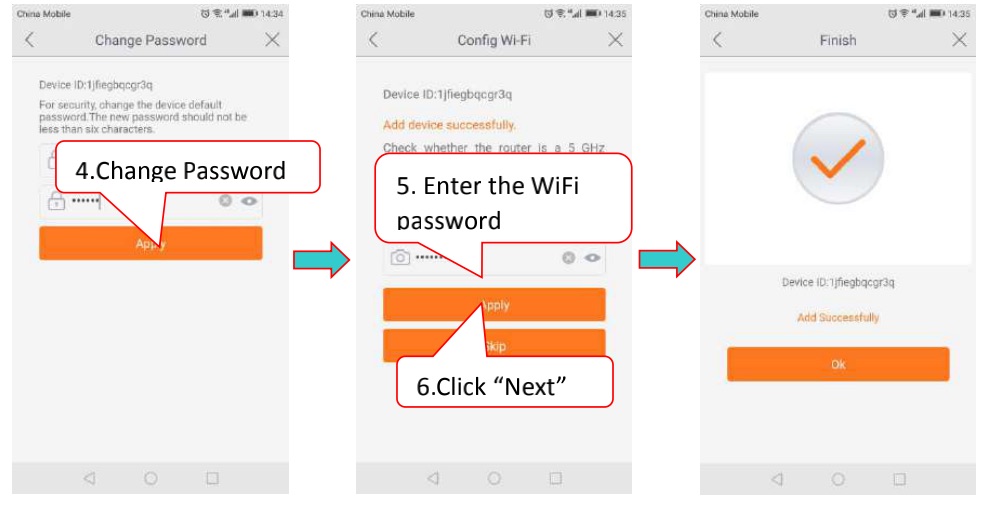
Using Apps for iPhone and Android
Camera List Previews
The camera list panel contains all cameras you have added to your account. Each preview picture has various indicators for online, password changed status,offline or alarm.
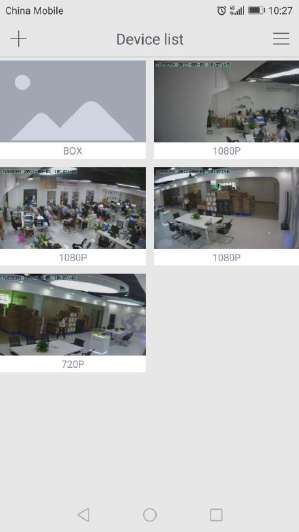
Account Settings for Mobile Devices
The Settings page for iOS and Android are very similar. Minor differences are Account Settings for Mobile Devices indicated below.
The Settings page for mobile devices contains the following options:
User guest password:If you wish to allow someone access to your Camera, you can assign them a user guest password, which can be disabled at any time. Guests can view what the cameras are broadcasting and can move the cameras, but they will not be able to make any changes in the settings or use the remote microphone.
Binding email:Enter an email address. This is the email account to which Notification is sent when you ask to reset your password.
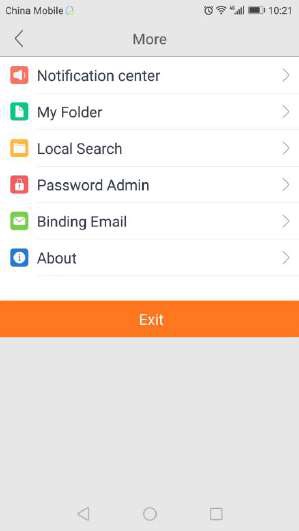
About:Software version
At the bottom of the screen, there is a Clear cache button. Click this to clear the cache on your mobile device. The original snapshots and/or videos stored on either your SD card or your Storage Device are not deleted when you click Clear Cache.
View a camera’s live video
To view a camera’s live video, touch a preview picture. Initial display will show a navigation bar with Buttons of record, snapshot, microphone, speaker, and Image setting buttons.The navigation bar will Disappear after two seconds.Touch anywhere on the live view to activate it again.
The following icons are located on each video image on the screen:
See also How to use Ebitcam PC Client
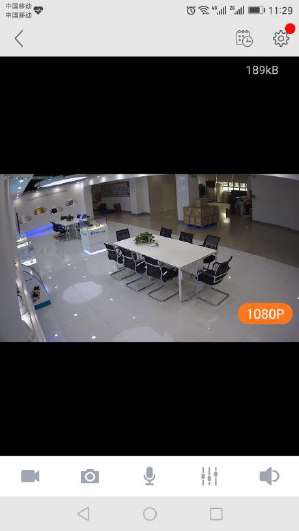
Pan, Tilt, Zoom
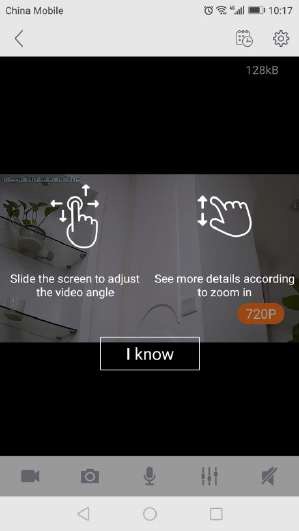
SD card video recording setup
Please go to Setting to enable the recording function after the SD card is inserted into the card slot on the camera.
Note: Please insert and remove the SD Card when the power switch is in the OFF position.
Step 1: View the video
Step 2: Go to Setting Page
Step 3: Select ‘Record’
Step 4: Select ‘Continuous Recording’
Step5: Open the ‘Enable Recording’ button, Click ‘Apply’
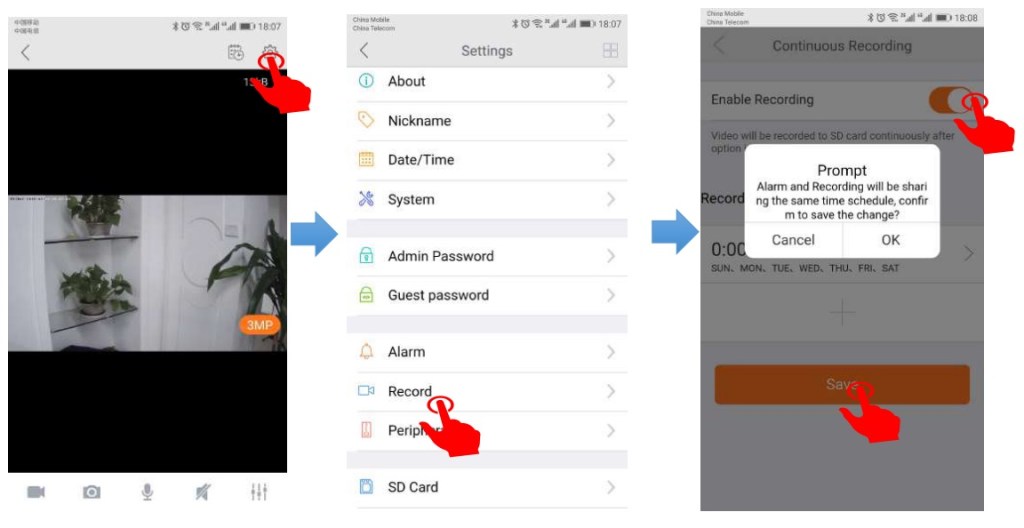
Device Settings
The Device Settings Page features a number of different tabs that are just to the right of your cameras. You are able to switch between the different cameras to access the settings information for each of them. Let’s look at the long list of items under this section.
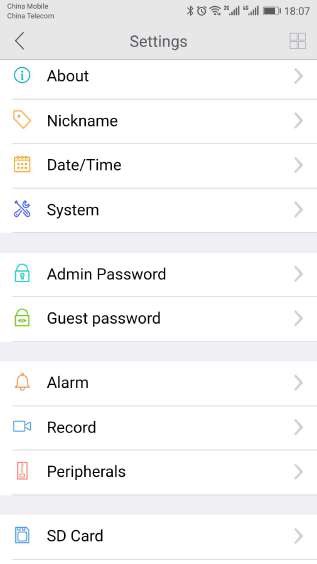
About
In this section, you will find information about the particular camera that you are using.
It features several sections:
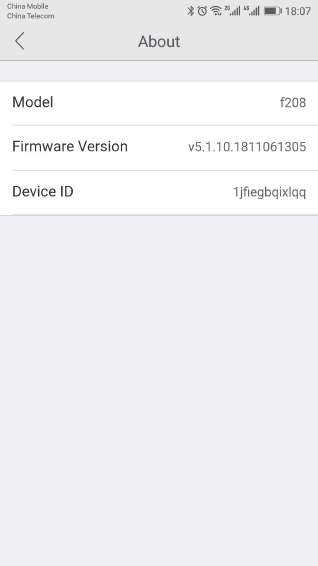
Nickname
In this section, you will be able to enter a nickname for your camera. Simply type the name into the box and then click on apply.
Now, that camera will go by that particular nickname when it shows up on the left side of the screen. This can make it nice and easy to know which camera is which quickly.
Date/Time
In the Date/Time tab, you can set the date and time for your camera. Choose the date, time, and the time zone. You can also choose to synchronize to the local date and time automatically. However, you can change the time manually if you prefer. You will want to have the correct date and time so you can schedule your recordings correctly.
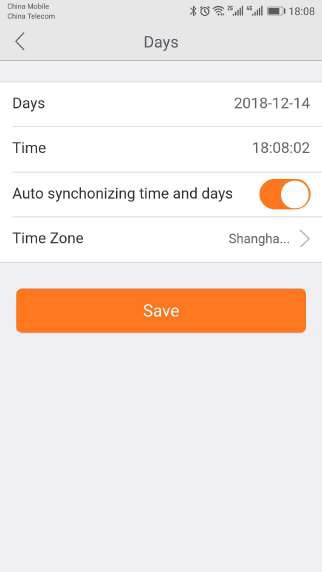
System
Under System, there are three sections under System, as detailed below:
● Online upgrade
Online upgrade displays the current version number and shows if there is a newer version. You will see a red dot next to the Setting icon identifying that there is a new upgrade available. To download and install the latest software version, click Update.
● Restore to factory settings
If you click Restore, it will restore the camera to the factory defaults, which can restore to factory settings be helpful in case you have made changes to the camera and want to cancel these changes.
● Restart device
Clicking Restart reboots the camera. It is the same as unplugging the camera and plugging it back in again but is accomplished remotely. Note: When the camera goes office, such as when using the Restart button, the snapshots are deleted if you do not have storage.
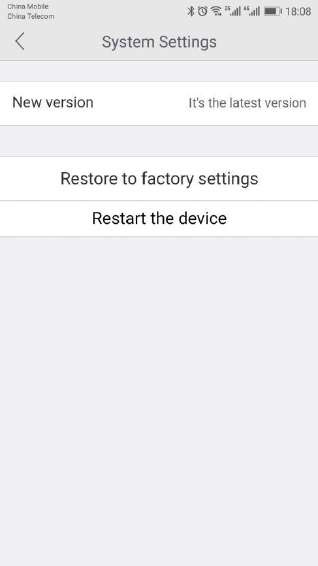
Device Admin/Guest Password
● Admin Password
Each camera can have an Admin password. You can choose to give a person admin permissions on a single camera, but not all of the other cameras in your system, when you change the password through this setting.
● Guest Password
If you wish to grant someone access to your camera, you can assign them a device guest password, which can be disabled at any time. Guests can view what the cameras are broadcasting and can move the cameras, but they will not be able to make any changes in the settings or use the remote microphone.
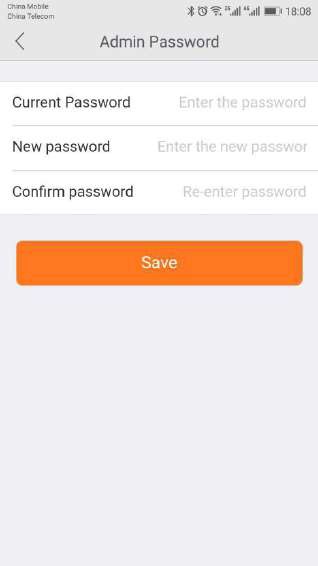
Alarm
The camera carries the mobile detection and alarm. After the mobile detection is opened, the alarm information can be sent to the mobile phone when the camera detects the moving events and the objects are moved.
See also How to use Ebitcam PC Client
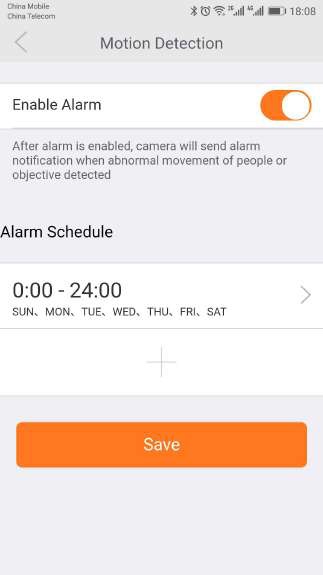
Record
Under the Record tab, you have the ability to enable recordings based on two different options: Continuous Recording and Event record. You should enable one of these options if you wish to schedule recording times automatically.
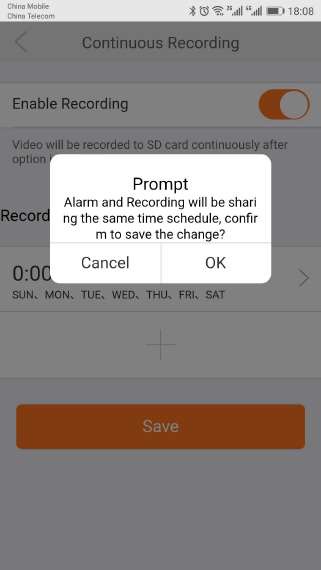
Accessory
The cameras can detect motion in the viewing areas and can as a result of that detection, take a snapshot, record a video, trigger an alert, etc.
The Accessory tab offers two options to configure what the camera should do if and when motion is detected in the covered area:
● Motion Detection
Select the Motion Detection tab to determine how sensitive the camera is when it comes to sensing motion. You can change the sensitivity settings for day and night operation separately to improve motion detection.
● Add Accessory
The Add Accessory is for external devices connected to the camera. This setting will only occur if the camera has RF peripheral functions.
SD Card
The SD Card section indicates whether you have an SD card in the camera and whether it is enabled.
● To use the SD card, place it into the slot on the back of the camera.
● If the camera does not recognize the SD card, remove the card and unplug the camera. Put in the SD card and then plug in the camera. The camera will reboot, and then it should be recognized.
Note: It is always recommended that you format the card after installation.
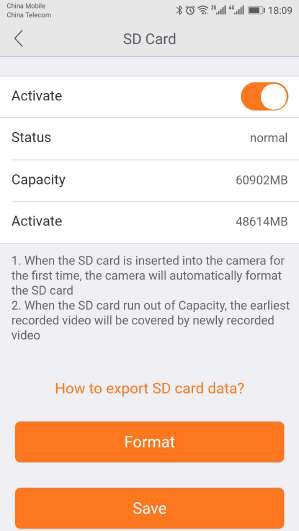
Recording Device
Using the Recording Device option, you can introduce another element of The Recording Device , the Cloud Box. The Cloud Box is an ideal DIY (Do It Yourself ) security solution for homes and small businesses that require the recording of many hours of continuous video.
To use a Cloud Box, you must first connect the Cloud Box to the same network where one or more cameras are connected. Once you have confirmed that the Cloud Box is connected, you need to enter the Cloud Box ID and password and enable its use in the Recording Device tab.
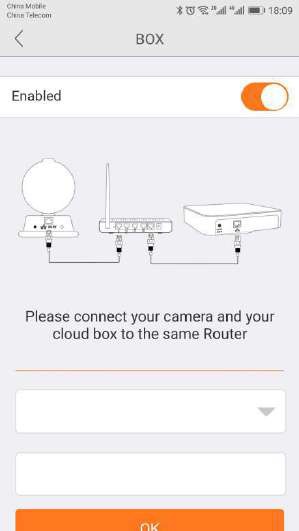
Cloud Storage
The cloud storage function is a video storage function developed by wireless ip cameras based on moving object detection technology.
When a camera detects moving events such as someone walked and objects were moved, the camera will automatically start to record,and highly encrypted upload to the cloud. At the same time effectively avoiding the loss of key evidence caused by human destruction, SD card damage, you can feel at ease.
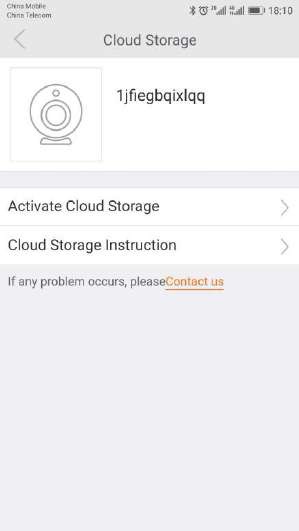
Network
Warning: If you change the settings on this tab, it is possible that the network can be disconnected.
The Network Tab enables you to choose the network interface that you want to use – Ethernet or Wi-Fi. When you choose Ethernet, you can view the MAC address, the network status, and the IP information.
Once your device is connected, it is recommended that you do not change the settings or click Apply on the Network tab, as this is likely to cause you to be disconnected from the Network.
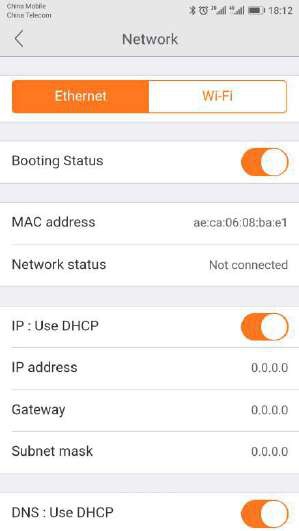
OSD (On Screen Display)
In the OSD tab, you are able to manage what displays on the video screen. These settings include:
● Display Text – Add text that will show up on the video screen.
● Display Date – Choose whether to display the date on the screen and the type of date format (MM-DD-YYY or YYY-MM-DD).
● Display Time – Choose whether to display the time on the screen and the time format (12 hour or 24 hour).
● Display Day of the Week – Choose whether to display the day of the weekon the live screen. After changing the settings, click Apply.
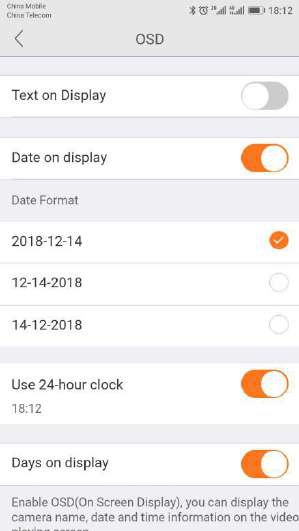
Others
Use the sliders to adjust the Speaker and the Microphone. You can make the Others volume higher or lower with these sliders. Sliding to the right makes the volume go higher, and sliding to the left makes it lower.
Flip is used when the camera is mounted upside down (for example, when it is attached to a ceiling). It will fiip the images viewed from the camera (either snapshot or recordings) so that they appear properly.
